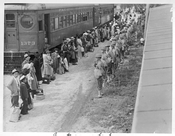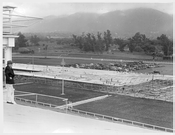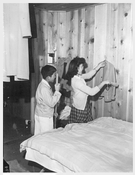When evacuees finally arrived at their destination they were usually met with armed guards, search lights, and barbed wire. These were all signs of a prison. One guard who was assigned at the Santa Anita Assembly Center described the evacuees:

Most of the assembly centers
were located in California. Although the design and the construction
varied in each center, most of the assembly centers were located
at race tracks and fairgrounds. The basic community consisted
 of blocks which housed between 600 to
800 people. Each block had its own showers, lavatories, and toilets
and in a majority of the centers its own mess hall. Family groups
were to be kept together inside the assembly centers and each
unit would be equipped with cots, mattresses, blankets, and pillows.
These were the standards of the WCCA, but the living arrangement
usually did not live up to these standards. A Japanese-American
who was temporary located to the Santa Anita Assembly Center
described the following living arrangements:
of blocks which housed between 600 to
800 people. Each block had its own showers, lavatories, and toilets
and in a majority of the centers its own mess hall. Family groups
were to be kept together inside the assembly centers and each
unit would be equipped with cots, mattresses, blankets, and pillows.
These were the standards of the WCCA, but the living arrangement
usually did not live up to these standards. A Japanese-American
who was temporary located to the Santa Anita Assembly Center
described the following living arrangements:
We were confined to horse stables. The horse stables were whitewashed. In the hot summers, the legs of the cots were sinking through the asphalt. We were given mattress covers and told to stuff straw in them. The toilet facilities were terrible. They were communal. There were no partitions. Toilet paper was rationed by family members. We had to, to bathe, go to the horse showers. The horses all took showers in there, regardless of sex, but with human beings, they built a partition . . .The women complained that the men were climbing over the top to view the women taking showers. [When the women complained] one of the officials said, are you sure you women are not climbing the walls to look at the men . . .
It had extra guard towers with a searchlight panoraming the camps, and it was very difficult to sleep because the light kept coming into our window. . . I wasn't in a stable area . . . [but] everyone who was in a stable area claimed that they were housed in the stall that housed the great Sea Biscuit (quoted in the Commission of Wartime Relocation and Internment of Civilians 1997: 139).
Evacuees immediately began improving their living quarters with whatever material they could find. Scrap lumber left over from construction provided the necessary tools which the evacuees used to enhance their quarters.

